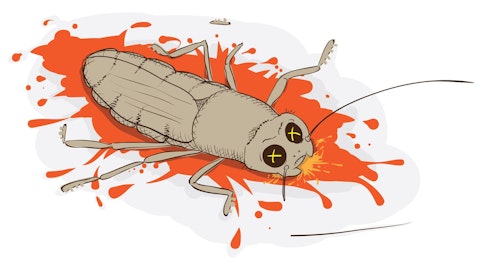Erin Kane: Yes. I can reiterate that our current order book is robust. It would be consistent with historical levels. Certainly, we think about where we’ve been over the last couple of quarters, we’re getting this reset off of very high nutrient values kind of resetting as we had said, as we come through, the supply chain was in a good spot post the spring season. We’ve progressed through that reset into fall fill based on the new sort of environmental context. And so we are happy with our order position and I think have continued to set a good order rate through fall. And we believe that as we head into spring, things will continue to be robust. And I would note as in our public postings that we have continued to take price up several times from our fill levels. So we’re progressing through the new season as expected.
David Silver: Okay. Very good. And then maybe one last one. More broadly on your Chemical Intermediates portfolio. So I’d like to maybe talk about not the acetone, but maybe the balance of the products there. And in particular, maybe the products you’ve taken control of via the U.S. Amines acquisition, sorry. But broadly speaking, I mean, the specialty nature of a lot of products tend to manifest themselves most clearly in kind of softer economic environment. In other words, it’s easy to maintain — easier to maintain prices and margins when fundamentals are reasonably balanced and tight, given the softer industrial environment for a prolonged period right now. I mean, how would you say the overall demand and I would just say, margin resilience of your broader chemical intermediates portfolio is right now? I mean how sturdy or how resilient would you say they the broader chemical intermediates portfolio, including U.S. Amines has been?
Erin Kane: Sure. If we think about the areas of intermediates, certainly in the higher-value applications and higher-value end products. We think of things like nadone going into electronics and specialty solvents. And as you mentioned, we think of the U.S. Amines portfolio like you also called out. And certainly, I would say there, the dynamic is, just as you would say, the pricing and the margins are resilient and do hold up because the value proposition of the chemistries are such as that. What we are seeing is more of the demand decline impact here. And so we think about the Ag chemical space for U.S. Amines, selling through into that chain. Volumes are down about 30% from the 5-year average cycle. So that does have an impact and it’s mostly the destocking associated with last year’s season that continues to play forward.
Whereas in a product like Nadone, that’s just more general, sort of consumer and demand considerations and cycles there. So I think you’re right here where our overall results, you see a large pricing and not so much of a volume consideration on our large-scale product lines, these more specialty ones, the pricing holds, the margin holds, and we’re seeing more of that demand impact.
Operator: Our final question comes from Charles Neivert of Piper Sandler.
Charles Neivert: Just one quick question. When I look at the split of earnings among the different segments that you guys report, it sounds clearly like the biggest impact has come in the nylon/Capro area and the other two have generally held up. So if we’re looking at round numbers, ex the turnaround. So we’re looking about round numbers, $35 million of EBITDA ex turnaround. What would the — how do you look at the split now versus the way the split was maybe in a substantially better time, meaning if I’ve got $35 million, round numbers divided equally among the 4 major segments you report, round numbers, it’s $8 million per, $9 million per. I mean where is — how does it look now? And how does it look in a more — for like a better term, normal situation. I mean, where the profitability is coming from?
Michael Preston: Yes. So I would — I think it’s — the themes are pretty consistent, right? And we shared, Charlie on the call here, the year-over-year bridge and the consideration around price raws for nylon being the largest year-over-year headwind from a consideration perspective, whereas when you look at price raws for both Ammonium Sulfate and Chemical Intermediates — ammonium sulfate, net of natural gas and sulfur actually being positive year-over-year, and then intermediates being relatively flat. So it’s really a nylon story. So relative to, I would say, a more normalized performance, Nylon’s mix in this because of the headwinds would be a bit lower, right, relative to the other product lines. And I would say acetone has been performing well, margins there being probably a greater mix of the total and ammonium sulfate despite the reset that we’ve seen here from the first half into the second half and a bigger seasonal impact on a relative basis still performing well and providing good returns and good income performance for the business.
Charles Neivert: Then when I look at Ammonium Sulfate now, sales going forward into next year, those are largely going to be U.S.-based sales as opposed to Lat Am, which is sort of the off-season sales. So we’ve now sort of shifted over to predominantly U.S. and therefore, more granular in the mix?
Erin Kane: Yes. I mean certainly, when you think about the first half sales, right? It does have that geographical consideration of more sales into North America because that’s the primary season and as you say, the granular piece, which is an important view as we continue to grow our granular conversion from 65% upwards to another 3% to 5% targets here for the year.
Charles Neivert: Now in terms of the sales, there’s a premium granular over — over standard grade, and you’re beginning to sell, I guess, a little bit more granular into the non-U.S. markets. Is that getting the same sort of premium that you would typically — I mean the price points itself may be lower, but the premium over standard grade, is that still in there even on the sales that are non-U.S?
Erin Kane: Correct. That’s important for us to think about. But most of our incremental sales for the expanded granular conversion programs is for targeting growth in the U.S. Sulfur — nutrients continue to grow here. So again, that is primarily to help the U.S. farmer, to help U.S. productivity. And so we anticipate that the primary market will be here.
Charles Neivert: And then two more quick things. Do you have — can you give me some indication about — you talked about operating rates globally. Are you guys in line with the U.S. operating rate? Are you a little bit better? And this is in the Capro area, a little bit better than the operating rates in the U.S. a little bit worse? Where do you guys stand?
Erin Kane: Yes. On Caprolactam rates, we continue to progress at or slightly above, depending on how we’re running. But that’s always been our opportunity set, Charles, as you know, that we have that opportunity set given the global cost position. It can fluctuate, like I said, with the planned turnarounds and other considerations, but that’s always our target, and we’re holding in there.




